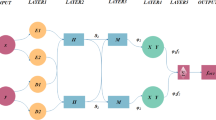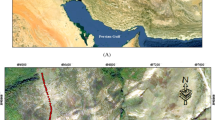Abstract
In this paper, the applicability of adaptive neuro-fuzzy inference system (ANFIS) for the prediction of groutability of granular soils with cement-based grouts is investigated. A database of 117 grouting case records with relevant geotechnical information was used to develop the ANFIS model. The proposed model uses the water–cement ratio of the grout, the relative density and fines content of the soil, the grouting pressure, and the ratio between the particle size of the soil corresponding to 15% finer and that of grout corresponding to 85% finer as input parameters. The accuracy of the proposed ANFIS model in terms of the corresponding coefficient of correlation (R) and root mean square error (RMSE) values is found to be quite satisfactory. Furthermore, a comparative analysis with existing groutability prediction methods indicates that the ANFIS model demonstrates superior performance.



Similar content being viewed by others
References
Eklund D, Stille H (2008) Penetrability due to filtration tendency of cement-based grouts. Tunn Undergr Space Technol 23:389–398
Kim J-S, Lee I-M, Jang J-H, Choi H (2009) Groutability of cement-based grout with consideration of viscosity and filtration phenomenon. Int J Numer Anal Methods Geomech 33:1771–1797
Sonebi M, Bassuoni MT, Kwasny J, Amanuddin AK (2014) Effect of nanosilica on rheology, fresh properties, and strength of cement-based grouts. J Mater Civ Eng 27:4014145
Akbulut S, Saglamer A (2002) Estimating the groutability of granular soils: a new approach. Tunn Undergr Space Technol 17:371–380
Schwarz LG (1997) Roles of rheology and chemical filtration on injectability of microfine cement grouts. Northwestern University, Evanston
Liao K-W, Fan J-C, Huang C-L (2011) An artificial neural network for groutability prediction of permeation grouting with microfine cement grouts. Comput Geotech 38:978–986
Ozgurel HG, Vipulanandan C (2005) Effect of grain size and distribution on permeability and mechanical behavior of acrylamide grouted sand. J Geotech Geoenviron Eng 131:1457–1465
Burwell EB (1958) Cement and clay grouting of foundations: practice of the corps of engineers. J Soil Mech Found Div 84:1–22
De Beer EE (1949) Grondmechanica. Deel II, Funderingen N. V. Standaard Boekhandel, Antwerp, pp 41–51
Incecik M, Ceren I (1995) Cement grouting model tests. Istanb Tech Univ Bull 48:305–318
Mitchell JK (1981) State of the art–soil improvement. In: Proceedings of 10th ICSMFE, pp 509–565
Tekin E, Akbas SO (2011) Artificial neural networks approach for estimating the groutability of granular soils with cement-based grouts. Bull Eng Geol Environ 70:153–161
Cheng M-Y, Hoang N-D (2014) Groutability prediction of microfine cement based soil improvement using evolutionary LS-SVM inference model. J Civ Eng Manage 20:839–848
Jang J-S (1993) ANFIS: adaptive-network-based fuzzy inference system. IEEE Trans Syst Man Cybern 23:665–685
Cabalar AF, Cevik A, Gokceoglu C (2012) Some applications of adaptive neuro-fuzzy inference system (ANFIS) in geotechnical engineering. Comput Geotech 40:14–33
Provenzano P, Ferlisi S, Musso A (2004) Interpretation of a model footing response through an adaptive neural fuzzy inference system. Comput Geotech 31:251–266
Gokceoglu C, Yesilnacar E, Sonmez H, Kayabasi A (2004) A neuro-fuzzy model for modulus of deformation of jointed rock masses. Comput Geotech 31:375–383
Kayadelen C, Günaydın O, Fener M et al (2009) Modeling of the angle of shearing resistance of soils using soft computing systems. Expert Syst Appl 36:11814–11826
Luis Rangel J, Iturrarán-Viveros U, Gustavo Ayala A, Cervantes F (2005) Tunnel stability analysis during construction using a neuro-fuzzy system. Int J Numer Anal Methods Geomech 29:1433–1456
Kalkan E, Akbulut S, Tortum A, Celik S (2009) Prediction of the unconfined compressive strength of compacted granular soils by using inference systems. Environ Geol 58:1429–1440
Kayadelen C, Taşkıran T, Günaydın O, Fener M (2009) Adaptive neuro-fuzzy modeling for the swelling potential of compacted soils. Environ Earth Sci 59:109–115
Sezer A, Göktepe BA, Altun S (2010) Adaptive neuro-fuzzy approach for sand permeability estimation. Environ Eng Manag J EEMJ 9:231–238
Samui P, Kim D, Viswanathan R (2015) Spatial variability of rock depth using adaptive neuro-fuzzy inference system (ANFIS) and multivariate adaptive regression spline (MARS). Environ Earth Sci 73:4265–4272
Landry E, Lees D, Naudts A (2000) New developments in rock and soil grouting: design and evaluation. Geotech News 18:38–48
Fahimifard SM, Salarpour M, Sabouhi M, Shirzady S (2009) Application of ANFIS to agricultural economic variables forecasting case study: poultry retail price. J Artif Intell 2:65–72
Guillaume S (2001) Designing fuzzy inference systems from data: an interpretability-oriented review. IEEE Trans Fuzzy Syst 9:426–443
Krueger E, Prior SA, Kurtener D et al (2011) Characterizing root distribution with adaptive neuro-fuzzy analysis. Int Agrophys 25:93–96
Takagi T, Sugeno M (1985) Fuzzy identification of systems and its applications to modeling and control. IEEE Trans Syst Man Cybern 1:116–132
Tekin E (2004) Experimental studies on the groutability of microfine cement (Rheocem 900) grouts to sands having various gradations, Gazi University
Zebovitz S, Krizek RJ, Atmatzidis DK (1989) Injection of fine sands with very fine cement grout. J Geotech Eng 115:1717–1733
Jang RJS, Gulley N (2000) Fuzzy logic toolbox user’s guide. The MathWorks, Inc, Natick
Willmott CJ, Matsuura K (2006) On the use of dimensioned measures of error to evaluate the performance of spatial interpolators. Int J Geogr Inf Sci 20:89–102
Tekin E, Akbas SO (2010) Estimation of the groutability of granular soils with cement-based grouts using discriminant analysis. J Fac Eng Archit Gazi Univ 25:625–633
Avci E (2009) Groutability of Ultrafin 12 cement grout into sands at various relative density and gradation. Dissertation, Gazi University
Author information
Authors and Affiliations
Corresponding author
Ethics declarations
Conflict of interest
The authors declare that they have no conflict of interest.
Electronic supplementary material
Below is the link to the electronic supplementary material.
Appendix
Appendix
trainData = [ 83 x 6 matrix (not shown here) ];
testData = [ 17 x 6 matrix (not shown here) ];
validData = [17 x 6 matrix (not shown here) ];
allData = [ 117 x 5 matrix (not shown here) ];
numMFs = [2 3 3 3 3];
mfType = str2mat(‘trapmf’,’trapmf’,’trapmf’,’trapmf’,’trapmf’);
fismat = genfis1(trainData,numMFs,mfType,’linear’);
[fismat1,error1,ss,fismat2,error2] = anfis(trainData,fismat,[],[],validData,1);
anfis_output = evalfis([allData], fismat2)
Rights and permissions
About this article
Cite this article
Tekin, E., Akbas, S.O. Predicting groutability of granular soils using adaptive neuro-fuzzy inference system. Neural Comput & Applic 31, 1091–1101 (2019). https://doi.org/10.1007/s00521-017-3140-3
Received:
Accepted:
Published:
Issue Date:
DOI: https://doi.org/10.1007/s00521-017-3140-3




